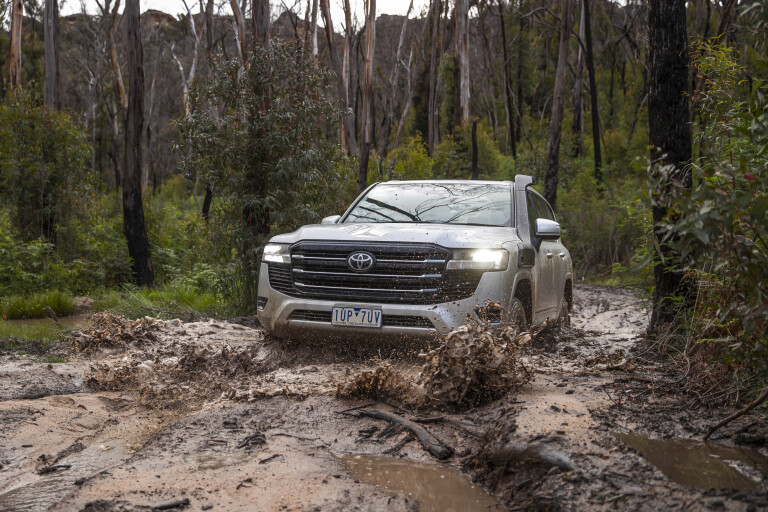
Things we like
- Engine/transmission combo is a ripper
- Properly capable off-road, and well-planted on-road
- Highest payload capacity in the LC300 range
Not so much
- Headlights are dull
- Factory fitted raised air intake is poorly sealed
- V6 engine looks complicated to work on
The 300 Series LandCruiser certainly has been getting plenty of attention in recent months, and for good reason.
It’s the first new LandCruiser in 14 years, and that’s a big deal. It’s also not a 200 Series LandCruiser anymore, which seems to have upset some people who think the V8 engine used in the 200 was the best thing since free cold beer on a hot day. I liked the 200 Series, I really did, but the 300 is better – it certainly hasn’t revolutionised the off-road game, but it’s a more refined vehicle overall.
UPDATE: 2022 4X4 of the Year
March 31, 2022: Hey, before you go on, you also should know which 4X4s are our top picks for 2022. Read our 2022 4X4 of the Year stories at the link below!
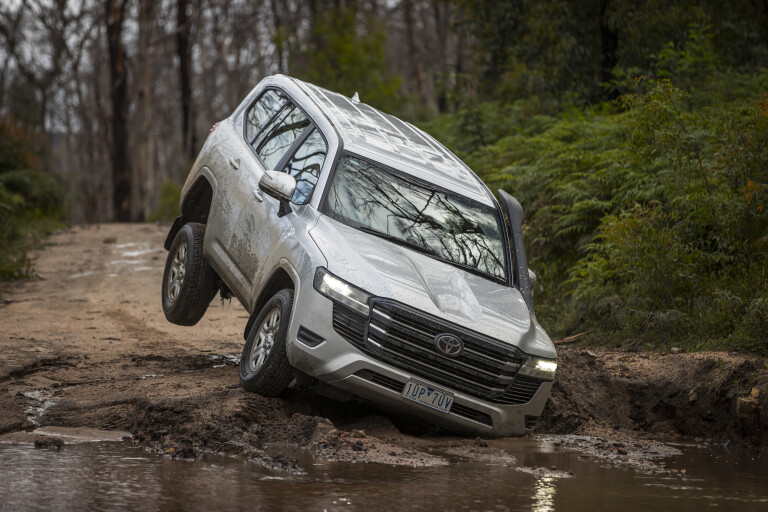
Speaking of refinement, today’s objective is to look at the lowest spec LC300, which is certainly not what anyone would call refined. The purpose of this exercise isn’t to debate whether the 200 Series is better than the 300, we’re just here to see if the lowest-spec (GX) 4x4 in the 300 Series line-up is worthy of your hard-earned dollars.
Is it too basic to live with daily? Should you spend an extra (nearly) $12,000 jumping up to the GXL variant? On the flip side, would it be a wise call to pocket that $12,000 and use it for aftermarket (or genuine) accessories and buy the GX instead? Enough with the questions, it’s time to get some answers on the GX.
Powertrain & performance
Toyota ditching the old V8 in favour of a twin-turbo V6 is big news. It shouldn’t be though, as the V6 is a stout performer. It pulls well through the rev range and feels particularly peppy in the mid-range. Low-down torque is tractor-like when crawling off-road, and it even sounds good when being pushed.
The motor in question is a 3.3-litre V6 twin-turbo diesel engine producing 227kW at 4000rpm and 700Nm from 1600 to 2600rpm, an increase of 27kW-50Nm over the V8 found in the 200 Series. It doesn’t matter which LC300 variant you are interested in, as you get the same engine and gearbox across the entire range.
The V6 is mated to a 10-speed automatic gearbox, which shifts smoothly and without complaint. It also helps reduce fuel consumption, with this GX returning an average of 11.5L/100km when tested over a variety of terrain (highway, urban and off-road) during the space of a week.
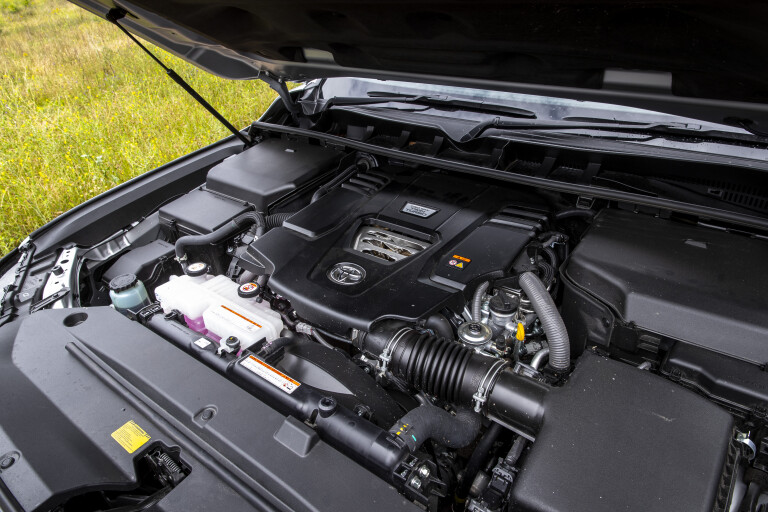
My main complaint with this package is from a visual point of view – it looks complicated to work on. When you lift that engine cover, the engine bay is messy and I’d imagine it would be a nightmare for mechanics. It will certainly be an interesting few years getting to know this engine package, finding where its strengths and weaknesses lie.
One such weakness is the location of the alternator. You can see it through an opening in the driver’s side wheel arch. While it’s a massive 200amp unit, which is impressive, it sits so low there’s no way it won’t cause issues down the line if you enjoy driving in mud.
There’s now also the more complicated water-to-air intercooler system, which adds additional components that could fail compared to the fairly bulletproof air-to-air top-mounted intercooler found in the 200 Series. Time will tell if that was a good call from Toyota.
On-road ride & handling
I had the opportunity to drive the GX during a week of extremely heavy rain and fog – utterly miserable conditions, basically. Despite this, I was impressed with how well-planted the vehicle is, and at no stage was it a handful to pilot in these lousy conditions. It gripped to the road with utter tenacity, and handled confidently no matter where I was driving, even at highway speeds on winding Blue Mountains roads.
One night coming home from an event in the city, on a particularly misty evening, the headlights really struggled to do their job – I actually got out of the vehicle to see if they were on. This is a major disappointment in an otherwise solid package. Aftermarket spotlights would be damn near mandatory if you needed to cover any rural kilometres in the GX once the sun went down.
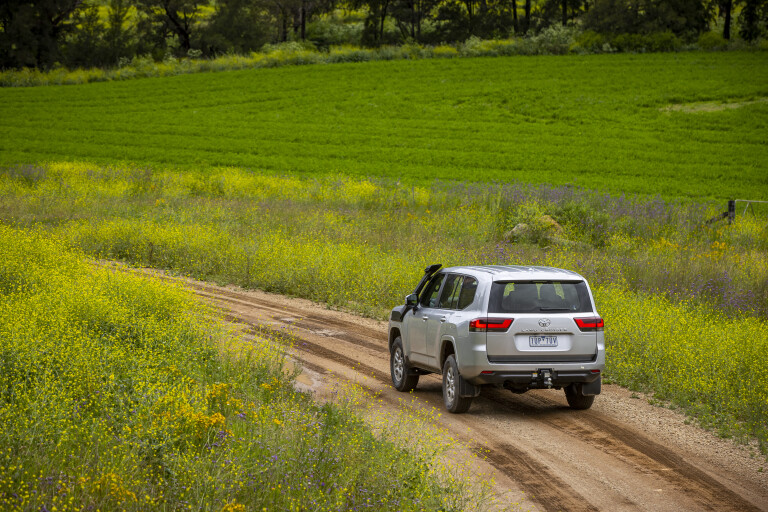
On a more positive note, the coil-sprung suspension performs brilliantly, with a firm yet progressive feel. Steering is also nicely weighted and direct for such a large wagon – full points there.
I’d happily drive the GX on a lap of the country in a heartbeat, and I don’t think I’d be longing for leather seats or a more luxurious interior at all in that time. Sure, it’s basic but in no way does the GX feel cheap.
Off-road
Don’t be fooled by the piece of plastic hanging from the passenger’s side guard. It’s not a snorkel, despite Toyota calling it so in their spec sheet. The GX comes standard with this raised air intake, and from our investigations it is really poorly sealed.
I’d definitely look at installing a proper aftermarket snorkel if you plan on taking a GX off-road, or at very least spend $20 on a tube of sensor-safe silicon and really ‘slaz’ (that’s a real word, I promise) it up properly.
With that small rant out of the way, the GX LC300 performed admirably on test through the Capertee area of NSW. Suspension travel, especially from the live rear axle, is impressive, and the traction control system is super responsive and I really enjoyed using the Crawl function on steep descents.
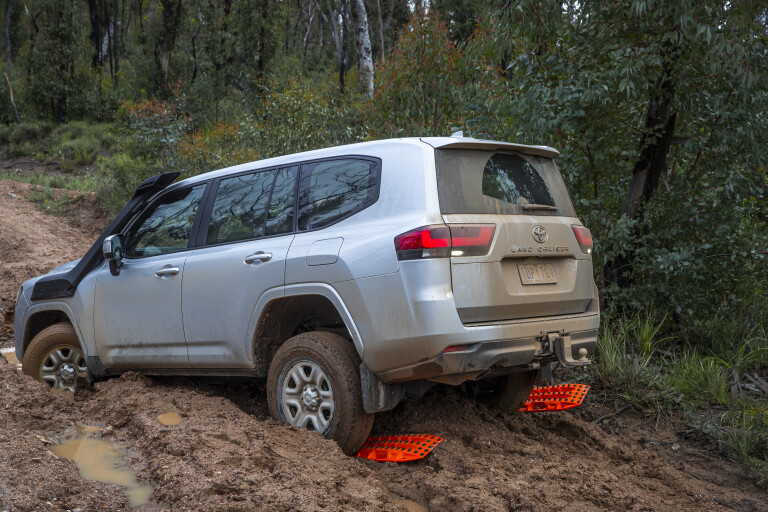
It was jerky and unpleasant to use when it first came out, but Toyota has dialled it in with the 300 Series. It’s a useful tool for those new to 4WDing, as well as experienced operators, allowing you to control the speed of the vehicle in increments by simply turning a dial.
It is also great to see off-road-friendly 17-inch wheels on the GX; they are a good quality steel wheel too. However, the 245/75R17 Dunlop tyres fitted were the biggest let down, as they struggled on the wet, muddy tracks we were exploring – they are road-biased tyres, at the end of the day.
A set of quality off-road light truck construction all-terrain rubber will transform the off-road ability of any LC300. It would be the first thing I’d upgrade.
Cabin & accommodation
Inside you are greeted with vinyl flooring and five (no seven-seat option in the GX) cloth seats, both inclusions I’m a fan of in a four-wheel drive. The dash layout is similar across the LC300 range, but you do notice more hard plastics and less features in the stripped-back GX model.
There is a distinct lack of USB points in the GX, which is a minor gripe but an important one, with only one USB and one USB-C in the front. There are no USB points in the rear, but there is a 12V cigarette plug – I would recommend buying a simple adaptor to convert that to USB.

There are six cupholders, 10 airbags, dual-zone automatic climate control and an electric park brake (boo). The infotainment unit is basic and small in size, as you’d expect in a base model – but it has a few tricks up its sleeve such as six speakers (which sound pretty good), Bluetooth compatibility, voice recognition, and Apple CarPlay and Android Auto compatibility.
At the back of the GX you’ll notice a one-piece lift-up rear tailgate, which isn’t a great idea. By design, it sits very low when opened. I complained about this with the new Isuzu MU-X, but the 300 Series is worse – you will hit your head on it if you aren’t careful. I definitely miss the split tailgate found on previous Cruisers, a practical place to make a sandwich, or to sit on and watch the world pass by.
Practicalities
It doesn’t really get more practical than a large four-wheel drive wagon with vinyl flooring and rubber floor mats, and there’s ample space for all occupants and their cargo. Thanks to the lower weight of the GX, payload capacity is the highest in the LC300 range, with 785kg to play with.
The seats are basic but comfortable enough for long stints behind the wheel, and there’s plenty of headroom for taller drivers.
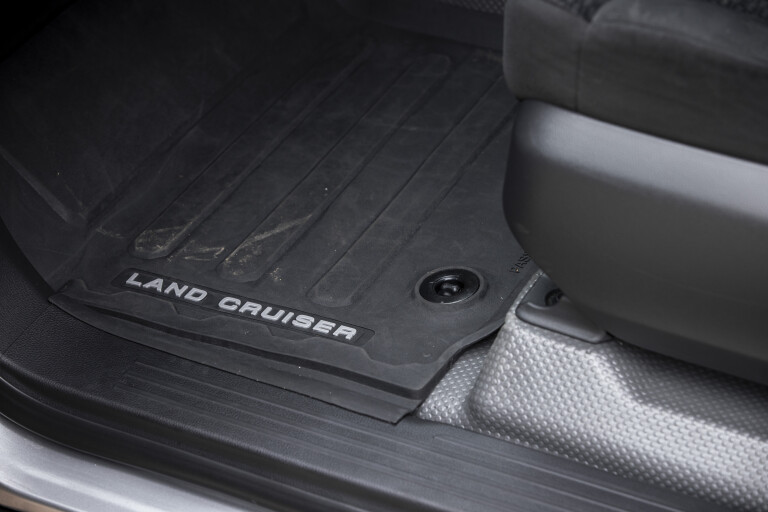
Maximum towing capacity is 3500kg, as you’d expect, and it’s safe to say many people will buy the 300 Series to tow. This is a task the Cruiser is well-designed to handle, from my limited experience hitching up a massive Kedron caravan at the initial LC300 launch a few months back. In fact, a towing wiring harness is fitted as standard equipment, making it one step easier to set up as a hauler.
Fuel capacity is down compared to the 200 Series LandCruiser, with 110L of capacity split between a main and sub fuel tanks (80L main; 30L sub). Toyota says this is due to the more efficient V6 used in the LC300, and it’s also a quick and easy way to shave overall weight off the vehicle. By our calculations, you’d be getting just shy of 1000km before both tanks were bone dry, which is respectable.
Verdict
The GX LC300 is far from a pov-pack model and is a solid leap forward in this lower spec compared to the 200 Series. For a $90,000 vehicle though, it would be criminal to call it luxurious. It’s a workhorse of a wagon, but a modern workhorse.
You can use it as a tool and not be afraid to get a bit of mud inside. Then you can take your partner to dinner and a show in town, while enjoying the same engine and gearbox package as top-spec LC300s. You’re also lugging around less weight, and pocketing some cash in the process. There’s plenty going for it.
You do miss out on a few key items, mainly seven seats (if you need them), some safety tech, MTS (Multi Terrain Select) for off-road trickery and a few plusher interior inclusions. That’s up to you to decide if those extras are worth an extra $12,000 to step up to the GXL.

I’d be buying a GX and spending the extra money on accessories. I don’t need seven seats; I’m messy, so the vinyl flooring gets a tick; and I enjoyed the relative yet endearing simplicity of the GX. I’d be adding accessories like all-terrain tyres, a bullbar and a proper snorkel, which will see the GX LC300 getting most places you’d want to go.
I’m struggling to think of a better off-road touring-friendly wagon available off the showroom floor today, but I haven’t driven an INEOS Grenadier yet. Now, that will be an interesting comparison …
2022 Toyota LandCruiser 300 GX specifications
| ENGINE | V6 twin-turbo diesel |
|---|---|
| CAPACITY | 3346cc |
| MAX POWER | 227kW at 4000rpm |
| MAX TORQUE | 700Nm at 1600 to 2600rpm |
| GEARBOX | 10-speed automatic |
| CRAWL RATIO | 42.62:1 |
| 4X4 SYSTEM | Full-time 4x4 w/ high/low range and centre diff lock |
| CONSTRUCTION | 5-door wagon body on ladder chassis |
| FRONT SUSPENSION | Double wishbone independent suspension w/ coil springs |
| REAR SUSPENSION | Live axle located 4-link rear w/ lateral control arm and coil springs |
| TYRE/WHEEL | 245/75R17 / 17-inch steel |
| KERB WEIGHT | 2495kg |
| GVM | 3280kg |
| PAYLOAD | 785kg |
| TOWING CAPACITY | 3500kg |
| GCM | 6750kg |
| SEATING | 5 |
| FUEL TANK | 110L |
| ADR FUEL CLAIM | 8.9L/100km |
| ON-TEST FUEL USE | 11.5L/100km |
| DEPARTURE ANGLE | 25° |
| APPROACH ANGLE | 32° |
| RAMPOVER ANGLE | 21° |
| WADING DEPTH | 700mm |
| GROUND CLEARANCE | 235mm |
Things we like
- Engine/transmission combo is a ripper
- Properly capable off-road, and well-planted on-road
- Highest payload capacity in the LC300 range
Not so much
- Headlights are dull
- Factory fitted raised air intake is poorly sealed
- V6 engine looks complicated to work on



COMMENTS